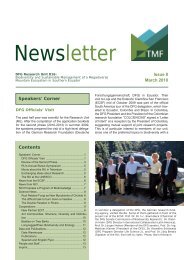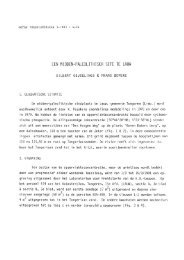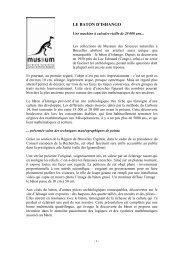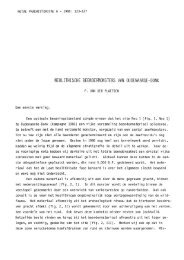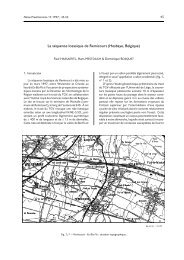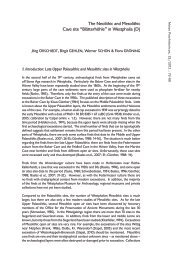Terebratula Daleidensis - Royal Belgian Institute of Natural Sciences
Terebratula Daleidensis - Royal Belgian Institute of Natural Sciences
Terebratula Daleidensis - Royal Belgian Institute of Natural Sciences
You also want an ePaper? Increase the reach of your titles
YUMPU automatically turns print PDFs into web optimized ePapers that Google loves.
54 Paul SARTENAER<br />
<strong>of</strong> Juseret (Neufchâteau Syncline); 1942, p. 270, from<br />
the Lower Emsian <strong>of</strong> Ziegenberg (eastern Taunus)];<br />
- “Zwischenstufe” between RoemeR’s (1844) T.<br />
<strong>Daleidensis</strong> and SchnuR’s (1853) T. hexatoma<br />
[GüRich, 1896, p. 284 and Sobolev, 1909, p. 508,<br />
from the “Spiriferensandstein” <strong>of</strong> the northern Holy<br />
Cross Mountains (Miejska Góra)];<br />
- small variety [Kay S e R, 1895, p. 208, pl. III, figs 1-2<br />
from the Lower Couvinian <strong>of</strong> Pepinster, considered<br />
as a juvenile specimen <strong>of</strong> Rhynchonella daleidensis;<br />
Dewalque (in de PieRpont, 1895, pp. 169, 171, 173,<br />
174), and de DoRlodot (1901, p. 174, foot-note 1, p.<br />
182, p. 182, foot-note 1), from the Lower Couvinian<br />
<strong>of</strong> the Vesdre Massif (Pepinster) and the southern<br />
flank <strong>of</strong> Lustin (Hestroy, Burnot) and Godinne<br />
(Rouillon) Anticlines in the Meuse river valley in the<br />
central part <strong>of</strong> the Dinant Basin].<br />
Varieties (formally named)<br />
The variety Rhynchonella daleidensis gracilior from<br />
the Lower Emsian <strong>of</strong> the Lorelei area (middle Rhine<br />
valley) was proposed by FuchS (1899, pp. 69, 74, 84,<br />
86, 88) and considered by him as “sehr bezeichnend für<br />
die höheren Niveaus der Hercyniaezone [“Singh<strong>of</strong>en-<br />
Schichten]”. The variety has also been mentioned: 1)<br />
from the Upper Emsian <strong>of</strong> the Bergisches Land by<br />
fuchS in SpRieSteRSbach & FuchS [1909, pp. 6, 70<br />
as a variety similar (“derartig”) to the variety gracilior;<br />
one crushed specimen], 2) from the Upper Emsian<br />
(“Kahlebergsandstein”, Giengelberger Schichten”,<br />
“Nessigi-Schichten”, “Schalker Schichten”, “Festenburger<br />
Schichten”, and “Rammelsberger Schichten”<strong>of</strong><br />
the Harz Mountains by DahmeR [1921, table, p. 174<br />
possibly, p. 191, table, p. 198, pp. 206, 277-279, pl.<br />
15, figs 18-20 (= three specimens from the “Nessigi-<br />
Schichten”), table, p. 300; 1946, p. 179]. This<br />
identification was confirmed by FuchS in DahmeR,<br />
1921, who compared it with the small <strong>Belgian</strong> variety<br />
<strong>of</strong> daleidensis from the Lower Couvinian <strong>of</strong> Pepinster<br />
described by Kay S e R (1895, p. 208). FuchS, however,<br />
referred to Kay S e R’s pl. III, figs 1-4, that Kay S e R<br />
considered as juvenile (pl. III, figs 1-2) and “normal”<br />
(pl. III, figs 3,4) forms <strong>of</strong> daleidensis (Remark:<br />
ASSelbeRghS, 1923, p. 25, pl. I, figs 4-9, attributed the<br />
specimens identified as Camarotoechia daleidensis by<br />
Kay S e R to C. imitatrix); 3) from the Lower Couvinian<br />
on the southern border (Olloy area) <strong>of</strong> the Dinant Basin<br />
by Maillieux (1939, p. 2 as C. gracilior); and 4) from<br />
the Emsian <strong>of</strong> Paphlagonia (Asia Minor) by HeRitSch<br />
& von GaeRtneR (1929, pp. 191-193, pl. 1, figs 12-<br />
13), and Paeckelmann & SieveRtS (1932, p. 55).<br />
Maillieux (1931, pp. 23, 25 as C. gracilior)<br />
contemplated the possibility that Camarotoechia<br />
imitatrix and Rhynchonella daleidensis gracilior could<br />
be synonyms.<br />
MittmeyeR (2008, table 2, p. 142, pp. 171, 173 as<br />
Oligoptycherhynchus daleidensis gracilior) has given<br />
a fresh impetus to the variety in mentioning it in the<br />
middle Lower Emsian Singh<strong>of</strong>en Substage (i.e. in the<br />
lower part <strong>of</strong> the Lower Bendorf Beds), the lower part<br />
<strong>of</strong> the Spitznack Beds (lower part <strong>of</strong> the Singh<strong>of</strong>en<br />
Substage = stratum typicum <strong>of</strong> the variety), and in the<br />
Wambach Beds (new lithostratigraphic unit). These<br />
beds extend, according to MittmeyeR, to western<br />
Westerwald and the Mosel river region, the Taunus<br />
and eastern Hunsrück, and the southern Taunus,<br />
respectively. MittmeyeR (2008, p. 203) considers O.<br />
prodaleidensis n. sp. a forerunner (“Vorläufer”) <strong>of</strong> O.<br />
daleidensis gracilior (see below).<br />
FuchS’ (1899) gracilior is a nomen nudum; it has<br />
neither been described nor defined in accordance<br />
with Article 12 <strong>of</strong> the ICZN. This is also the case for<br />
DahmeR’s (1921) gracilior, because expressions such<br />
as “eine kleine zierliche Form von der Verwandtschaft<br />
daleidensis” (Kahlebergsandstein, Upper Emsian,<br />
Harz Mountains) or “eine zwerghafte Abart” (Lower<br />
Emsian, Lorelei area, middle Rhine valley) cannot be<br />
considered as descriptions or definitions; specimens <strong>of</strong><br />
figures 18-20, plate 15, are also not an indication (Article<br />
12c). DahmeR himself admitted (p. 278) that a closer<br />
description (“eine nähere Beschreibung”) <strong>of</strong> the variety<br />
did not exist. The name gracilior may be made available<br />
later with a new authorship. DahmeR submitted his<br />
collection from the Harz Mountains to FuchS, who<br />
found it very much alike (“übereinstimmend”) gracilior<br />
from the middle Rhine valley. Such conformity needs<br />
to be substantiated. Furthermore all small forms with<br />
4<br />
median costae cannot be put in the same basket no<br />
3<br />
matter their age (early Emsian, late Emsian, and early<br />
Couvinian) and their geographic location (middle Rhine<br />
valley, Taunus, Hunsrück, Westerwald, Bergisches<br />
Land, Harz Mountains, and Dinant Basin).<br />
For the time being, the relation <strong>of</strong> gracilior<br />
with the late Emsian daleidensis from the Daleiden<br />
“Muldengruppe” (Eifel area), and its assignment to<br />
the middle Eifelian genus Oligoptycherhynchus is not<br />
acceptable. MittmeyeR intended to give a description<br />
and an illustration <strong>of</strong> gracilior based on his large<br />
collections from the Singh<strong>of</strong>en Substage (stratum<br />
typicum), but could not do this in the context <strong>of</strong> the<br />
compendium on the Devonian <strong>of</strong> Germany, published<br />
in 2008.<br />
The subspecies O. daleidensis minor (FuchS)



